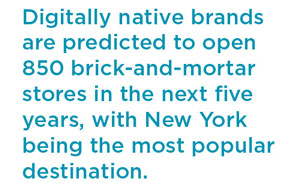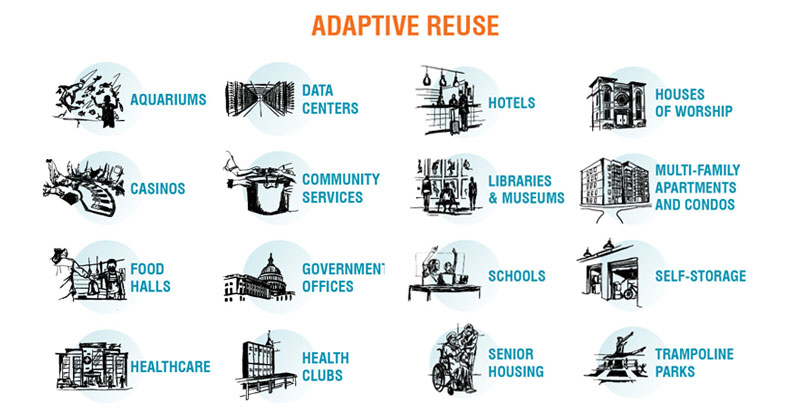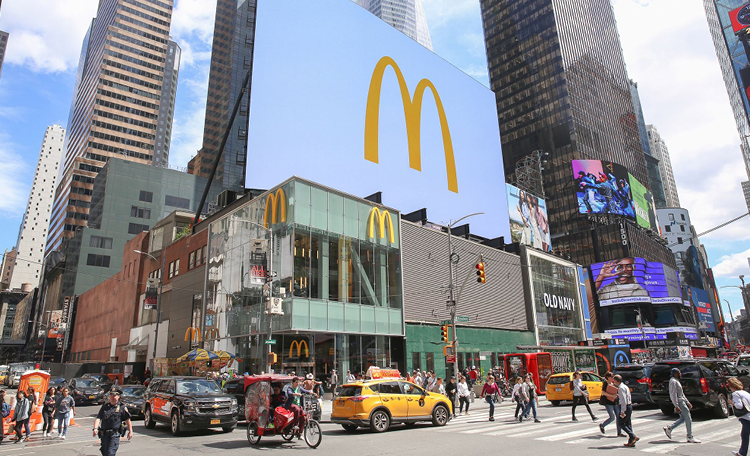
What does the future hold for the shopping mall?
There are currently more than 1,000 malls struggling to re-engage a consumer distracted by the convenience of digital offerings. With the continued growth of e-commerce, the introduction of new paths to purchase, and the impact of COVID-19, mall developers are faced with difficult challenges and the ultimate question: what does the future hold for the shopping mall?
 The Evolution of the Mall
The Evolution of the Mall
As children of the 70s, the mall represented a magical place. A symbol of possibilities. Armed with our allowance, the options were endless: denim from the Gap, shoes from Thom McCan, a quarter pounder from McDonald’s. The mall welcomed everyone, and it housed everything. As time progressed, so did the mall. Movie theaters, food courts and bars extended our stay and expanded our spending. Each year, developers, landlords and retailers put more emphasis on driving footsteps to shops, restaurants and theaters. Wall Street rewarded strong sales with strong stock performance. Then, in the early 2000s, everything changed as consumers shifted their focus to experiences over clothes, and convenience over community.
During the last decade, we have seen even further erosion of the mall experience. Malls have seen thousands of stores close, consumers disengage and communities struggling to understand the intrinsic value to the neighborhood. But instead of writing retail’s obituary, we should think of the retail market as merely evolving. Successful retail adapts as consumer preferences, habits and technology change—and one of the most prominent of these changes has been the shift to e-commerce.
Online sales had been effectively growing at a compound annual rate of 15.2 percent from2010 to 2019, vs. 4.2 percent for physical store sales (U.S. Census Bureau). Putting it into perspective, this channel accounts for about 16.1 percent of all retail sales. And COVID-19 has forced consumer behavior to adapt to this platform at an even faster rate. To that end, some analysts expect that e-commerce sales could account for 20 to 25 percent of all retail sales by 2025.
The reality is that physical stores that are still doing business the same way are no longer convenient in the age of e-commerce. To stay viable, both retailers and mall owners need to adapt to these fast-changing consumer preferences.
Survival of the Fittest
For the past several years, the department store model—once the lifeblood of the mall—has been in transition. There have been countless bankruptcies, closures, consolidations and liquidations within this once formidable segment of the retail industry. At one time, department stores were the center of the retail universe and viewed as innovators in merchandising techniques and customer service. But unfortunately, department stores started to lag their nimbler competitors and saw market share slip from more than 10 percent to under two percent today.
Besides having to deal with millions of square feet which will need to be backfilled or repurposed, mall owners are faced with looming co-tenancy clauses that can be triggered if they can’t replace an anchor tenant with an acceptable alternative. Co-tenancy clauses allow tenants to opt to pay percent rent only, a reduced rent, or the ability to vacate without penalty.
Over the past several months, mall owners have been in daily discussions with tenants to find ways tosurvive this crisis. This has resulted in some creative give-and-take from both the landlord and the tenant as each strives for the necessary modifications that work for all parties. Lease modifications continue to be achieved with the most common structure being deferral of a portion of the rent which is expected to be paid back over the next six to 12 months. Smartly, landlords are using these concessions as an opportunity to revamp clauses considered favorable to the tenant for their own benefit.
An interesting example of a survival strategy entails a shopping center owner buying a retailer, Aeropostale, who is a tenant in many of their malls. In 2016, Simon and the mall owner General Growth Properties, which is now owned by Brookfield, teamed up with Authentic Brands Group (ABG) to rescue the embattled teen apparel retailer. The three won an auction to buy Aeropostale out of bankruptcy court, salvaging hundreds of stores, for a price tag of $243.3 million. By all reports, this has turned out to be an accretive investment for the venture. This was soon followed by the acquisition of Forever 21. More recently, ABG and Simon, through a joint venture known as SPARC Group, have announced the acquisitions of Lucky Brand and Brooks Brothers. Brookfield and Simon separately have made an investment in JC Penny and we expect that there will be more examples of this strategy in the near future.
As the long-held belief that the department store was the anchor for a mall's success has diminished, we have seen several new, innovative uses replace these fortress stores such as food halls, movie theaters, entertainment concepts and gyms—and grocery stores could be next on the list. This is a natural evolution of the slow but steady shift over the last decade of bringing more food and entertainment into the mall while reducing the footprint of apparel given its vulnerability to digital competitors. An example of a successful reuse of a former JC Penney store is when Wegmans, a privately held American supermarket chain, moved into Brookfield’s Natick Mall in Natick, Massachusetts, the first such location in a mall for the chain.
Adaptive Reuse
Adaptive reuse is another viable option mall owners should consider. Repurposing unused vacant spaces can be an excellent way to recoup revenue losses. Architects welcome the challenges brought on when tasked with repurposing vacant boxes, especially when given a full runway of artistic expression. From casinos to data centers to aquariums and everything in between, adaptive reuse options seem to be endless.
Don’t Forget About the Outside
COVID-19 has and will continue to influence changes within the mall, but what about outside the mall? Savvy owners have embraced ideas on how to make their parking lots revenue generating. About a year ago, Walmart launched “Walmart Reimagined” to create town-center type developments on parking lots at its Supercenter stores with the goal of creating a gathering place that encourages the community to hang out longer in the area. We’ve also seen pop-up drive-in theaters and workout classes make parking lots their temporary homes. Other uses such as community programming, ice skating rinks and farmers markets are getting strong interest as well. And in one ominous sign of the times, many mall parking lots are hosting drive-thru COVID-19
Change is not an Option, it’s Required
The business of delivering retail goods and services has reached an inflection point shaped by the competitive challenges transforming the industry before our eyes. COVID-19 has only accelerated this pace of change. Smart retailers and owners are making significant strides in adopting and implementing new strategies that will shape retail over the ensuing decade. Change is not an option; it is required for survival.
A Changing Retail Experience
Retailers that recognized the shift to digital early on and invested wisely in omnichannel strategies are now benefiting the most.
- Shopping with AR
The future is now: augmented reality (AR), machine learning and artificial intelligence(AI) are here to stay. Retailers are leveraging AR technology to bridge the gap between the digital and the physical. Mega-brands like Target, Lowes and Amazon have launched AR features that allow shoppers to picture furniture in their homes. With the AR market anticipated to reach $133 billion by 2021, smaller retailers are undoubtedly close behind. Another AI powered retail trend, “visual search,” allows shoppers to find and buy a product just by snapping a photo. AI works its magic to identify the product (or similar ones) across multiple sites and retailers in just a click.
- Physical stores for digitally native brands
While digitally native brands like Bonobos, Glossier, Casper and Warby Parker started online, many are launching and expanding their physical presence. According to real estate experts, digitally native brands are predicted to open 850 brick-and-mortar stores in the next five years, with New York being the most popular destination.
- Omnichannel experiences
The rise of omnichannel is sure to continue so retailers need to offer a consistent buying experience across channels, both online and off. As the lines between digital and physical shopping experiences blur, retailers need to be agile and responsive to customer needs with branded touchpoints at all parts of the buying journey.
- Pop-up shops
Temporary storefronts leverage the scarcity principle and the excitement of never before seen products to provide a social buzz and an experience that drives shoppers. This is a potential $80 to $100 billion business....digitally native brands are predicted to open 850 brick-and- mortar stores in the next five years, with New York being the most popular destination.
- Social shopping
E-commerce and social media are becoming intertwined. Shoppable Instagram posts and stories have been very popular and an efficient way to promote the brand. Sought after “influencers” have become wealthy as this new form of marketing has exploded.
- Same-day delivery
When it comes to online shopping, it seems like customer expectations for ship times are only getting faster. First came 2-day via the rise of Amazon Prime, then next-day. But in the age of instant gratification, shoppers want their orders ASAP. PwC reports that 88 percent of consumers are willing to pay for same-day or faster delivery. Walmart and Target reported Q2 results and they have made significant strides in this area. Reliance on third-party shipping partners could also become retail history. Long term, you'd expect to see other large retailers vertically integrate into fulfillment and last mile to better control their own destiny.
- Rental apparel
The rental apparel market is also becoming a huge business on the heels of Rent the Runway’s success. Major department stores and others like Urban Outfitters have joined the trend. This drive to have the most current products manifests in an innovative concept created by Re:store in San Francisco, which offers a rotational display of products made famous on Instagram. We do note that LeTote’s acquisition of Lord & Taylor may become the first casualty in this segment in the COVID-19 era.



